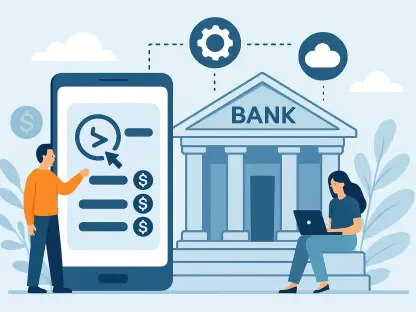In the rapidly evolving landscape of financial services, Bank of America is making significant strides to adapt by deciding to reduce its physical footprint across the United States by the end of 2025. This shift reflects changing consumer behavior, as digital and mobile banking have become the preferred methods for a vast majority of its clientele. Mobile log-ins have sharply outpaced traditional teller visits, leading the bank to reassess the necessity of its branches. Consequently, several branches in states like California, Texas, Nevada, Kentucky, and South Carolina are set to close, reflecting a broader trend across the nation.
The Rise of Digital Banking
Understanding Customer Preferences
The shift away from physical banking locations is not merely a strategic cost-cutting measure but a response to evolving customer preferences. As technology advances, more people prioritize the convenience and efficiency that digital platforms offer over traditional banking methods. For consumers, the ability to access banking services through smartphones and computers significantly changes how they manage their finances. The numbers illustrate this trend, with mobile log-ins far exceeding physical teller visits, demonstrating a clear preference for digital interactions.
Yet, for those customers who still value or require face-to-face service, Bank of America assures that they are not being left behind in this digital transformation. The bank emphasizes alternative channels through which services are continuously provided, including the fully functional website, mobile apps, a robust ATM network, and a 24/7 call center. Those who need in-person assistance are encouraged to visit nearby branches where available. This approach maintains a crucial balance between embracing digital trends and retaining essential traditional banking services for those reliant on them.
Digital Innovation and Accessibility
The pivot to digital banking by Bank of America underscores a pivotal moment in financial services where technology and accessibility intersect to create new opportunities for client interaction. Online and mobile platforms offer an array of services previously available only through in-person visits. Customers can now effortlessly check account balances, transfer funds, pay bills, and even apply for loans directly from their devices. These capabilities not only enhance user experience but also expand the reach of financial services, enabling customers to manage their finances on their terms anytime, anywhere.
Moreover, the increase in cyber threats has amplified the importance of secure digital transactions. Bank of America’s investment in cybersecurity illustrates its commitment to protecting consumer data, ensuring that digital banking is not only convenient but also safe. The bank’s approach involves using state-of-the-art security technologies and protocols, which lower risks while boosting customer confidence in digital transactions. By providing robust digital services, Bank of America is meeting modern demands while safeguarding against potential digital vulnerabilities.
Adapting to a New Banking Paradigm
Coping with Branch Closures
As Bank of America reduces its branch network, customers affected by these closures are encouraged to explore digital banking avenues. This transition aligns with a more comprehensive industry movement toward streamlined, tech-driven services. The bank has put measures in place to ensure a smooth shift for those accustomed to face-to-face interaction, showcasing the importance of understanding customer needs during such a significant transformation. By offering guidance and resources, Bank of America supports clients in this transition period, aiming to minimize disruption while maximizing service efficiency.
The narrative surrounding banking is clear: digitalization is a trend that is here to stay, presenting numerous benefits, from enhanced convenience to improved service accessibility. As more people grow comfortable with using digital tools, the emphasis is placed on educating customers about these platforms’ potential. By learning to leverage these tools, clients can streamline their banking activities while staying informed about vital account information, updates, and offers that may otherwise be missed in a traditional setting.
Balancing Technology with Personal Service
While digital banking offers numerous advantages, the importance of personal service remains a priority. Living in a digital-first world does not negate the value of human interaction, and Bank of America’s strategy reflects a conscious effort to blend technology with personal touchpoints. For complex financial advice or more intricate banking needs, in-person consultations at nearby branches continue, ensuring that clients receive a comprehensive service package that meets all preferences and requirements.
As Bank of America implements these changes, it signals a firm acknowledgment of the evolving consumer landscape. Balancing digital innovation with traditional service ensures that each client’s needs are met while adapting to contemporary banking trends. This balanced approach not only positions the bank favorably within the industry but also ensures sustained customer satisfaction as demands and preferences shift. Consequently, the bank is setting a strong precedent for future banking paradigms, prioritizing both technological advancement and customer-centric service.
Navigating the Future of Banking
Bank of America is taking significant steps to embrace the evolving financial services landscape by planning to downsize its physical presence across the United States by 2025. This strategic move highlights a shift in consumer preferences, with digital and mobile banking rising sharply in popularity among its customers. Modern technology has led to a dramatic increase in mobile log-ins, far surpassing visits to traditional bank tellers. Consequently, the bank is reevaluating the necessity and role of its brick-and-mortar branches. As part of this transition, branches in states such as California, Texas, Nevada, Kentucky, and South Carolina are slated for closure, mirroring a broader national trend. The decision reflects an understanding of changing client demands, positioning Bank of America to better serve its customers as they increasingly favor online platforms for their banking needs, ensuring the institution remains agile and responsive in a competitive environment.









